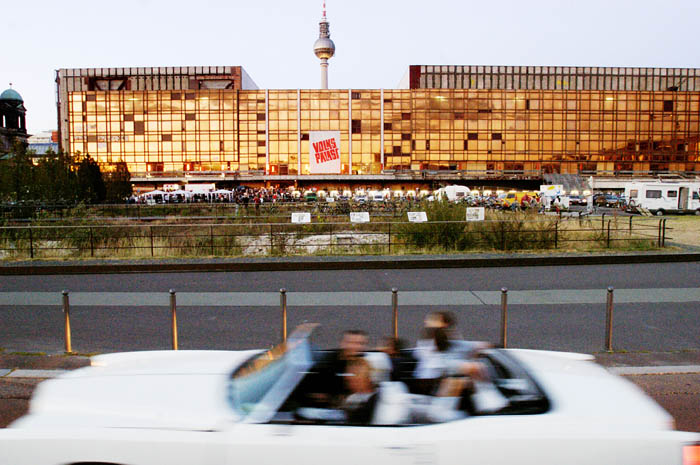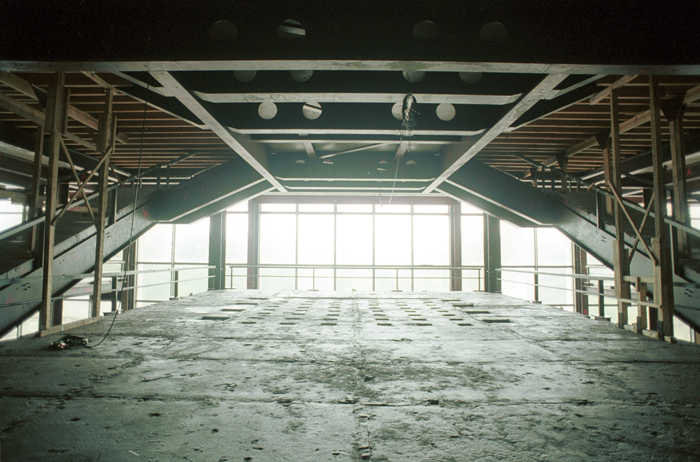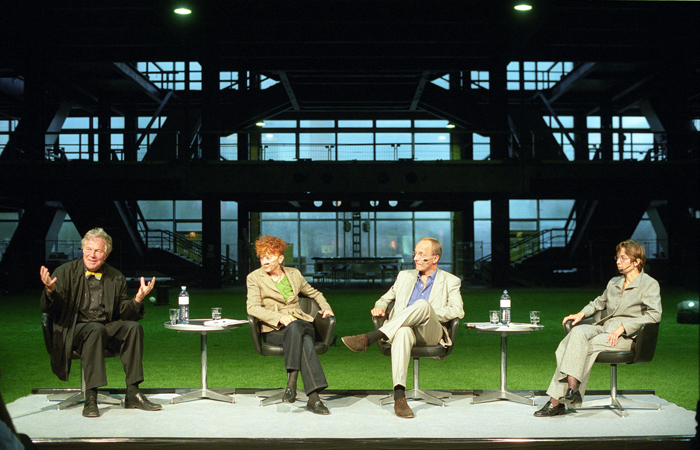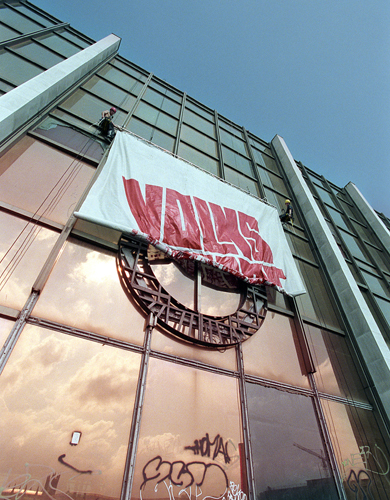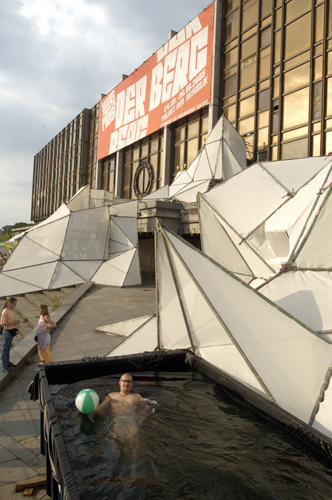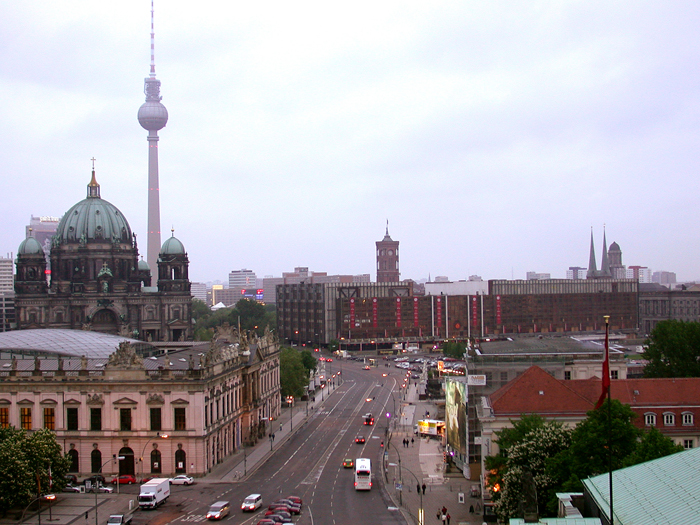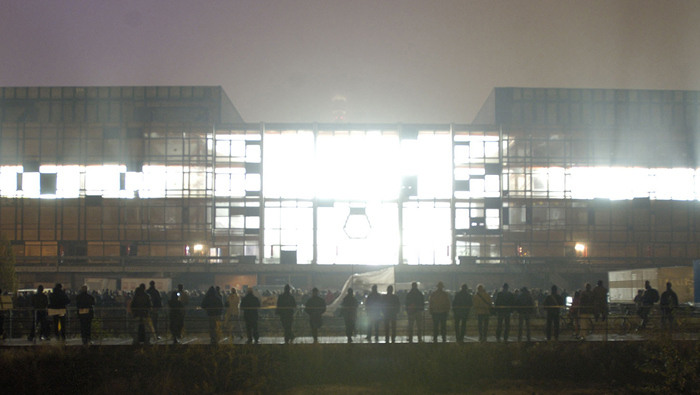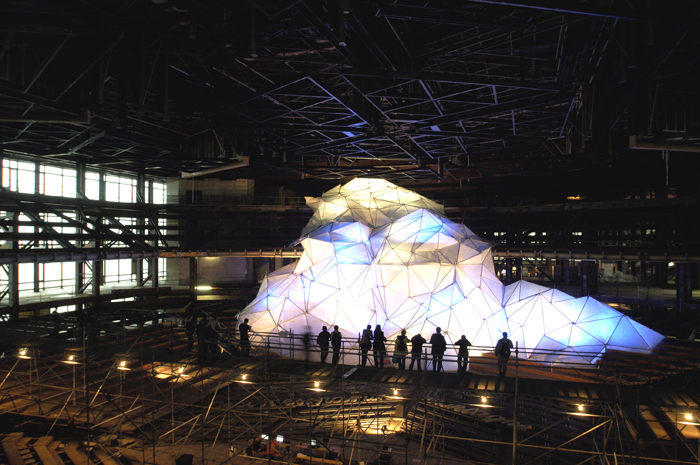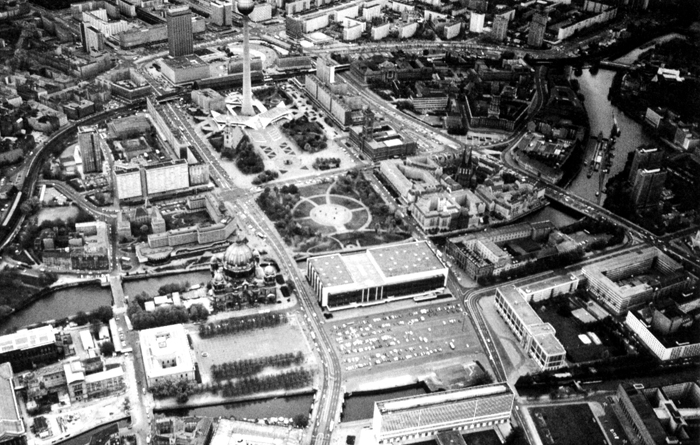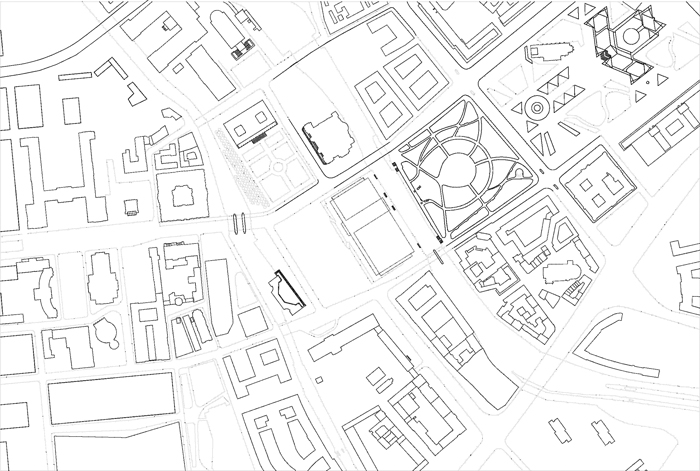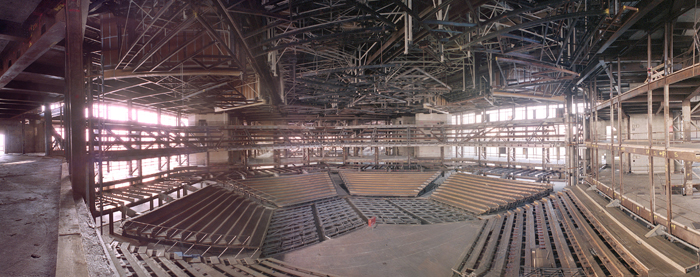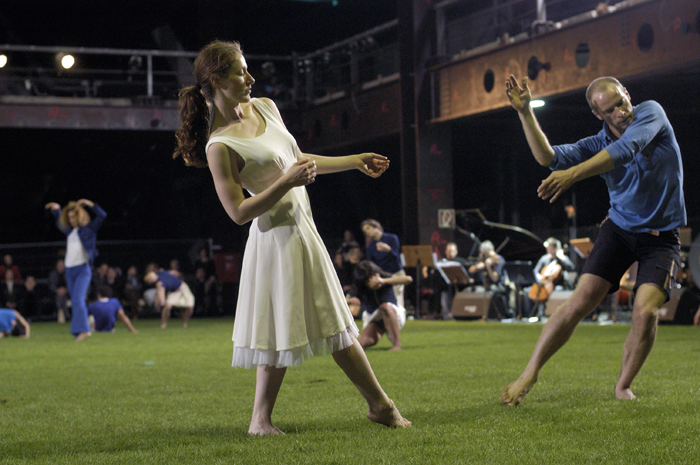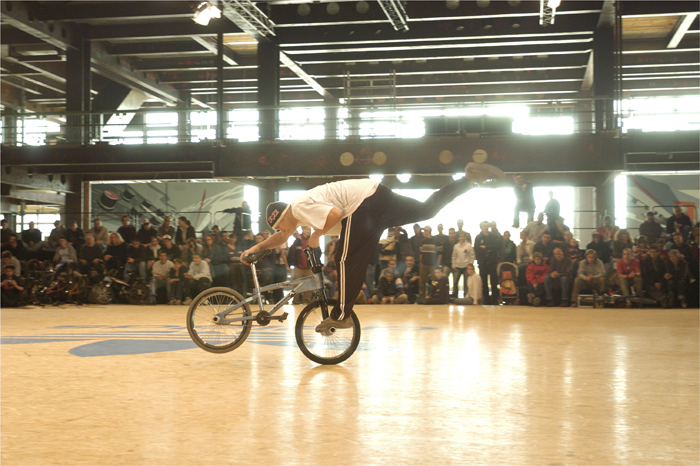Previous state
The Palast der Republik [Palace of the Republic] was an important building in the central Berlin district of Mitte. On the banks of the River Spree, at the end of the famous Unter der Linden Avenue, it dominated the Schlossplatz [Castle Square] with Berlin cathedral. It was built on the foundations of the Berliner Stadtschloss, the old castle that gave its name to the square and which, after being the residence of the kings and emperors of Prussia for four hundred years, was seriously damaged by the Allied bombings in 1945 and was demolished in 1950 by the authorities of the GDR, who considered it a symbol of Prussian imperialism.When it was inaugurated in 1976, the Palast der Republik was one of the most ambitious public buildings in the German Democratic Republic. With a rectangular ground plan, it was 180 metres long, 85 metres wide and 32 metres high. It housed the Volkskammer, the Parliament of the GDR, and an immense auditorium where the Unified Socialist Party of Germany [SED] met every five years. Moreover the building had a busy social and cultural life. In addition to the auditorium, where shows by national and international artists were put on, the palace also had its own small theatre, an art gallery, a restaurant with privileged supplies, a café-ice cream parlour, a disco, a billiard room and a post office that was open every day.
In 1990, one month after the reunification of the two Germanys, the presence of asbestos fibre, highly dangerous to the health, was detected in the Palast der Republik and the building was closed. After eight years of neglect, a costly intervention was begun in 1998 to remove all the asbestos, and in 2003 the building was dismantled, leaving an imposing steel and concrete skeleton which contained a gigantic, brutal empty space.
In November 2003, the Bundestag [German Parliament] decided to demolish the structure completely. As it was so close to the cathedral, the operation was highly delicate and complex and involved a cost of over 12 million euros. After a number of international architecture competitions had been convened, it was decided that a park would occupy the site provisionally until sufficient funds–over 600 million euros–had been collected for the construction of the Humboldt Forum, a complex made up of the Museum of Non-European Cultures, the Berlin Central and Regional Library and the Humboldt University Scientific Collection. The facade of this new complex had to literally reproduce the facade of the old Prussian imperial palace, the Berliner Stadtschloss, demolished in 1950.
Aim of the intervention
This project was the trigger that polarised and heated up a public debate over the future of the place which had been going on since the 1990s. On the one side the defenders of the castle wanted the palace to be completely demolished and the Prussian imperial original rebuilt, whilst on the other the defenders of the palace wanted the gigantic structure conserved as a setting for different temporary multidisciplinary activities. At a particular moment the controversy ran aground in the treacherous waters of the aesthetic connotations of the facade. While some thought that the bronzed, reflecting curtain wall of the Palast der Republik was simply ugly and recalled the oppressive architecture of the fallen regime, others argued that a literal reproduction of the Baroque facade of the Berliner Stadtschloss was more appropriate to a Disneyland than to the centre of Berlin.Having reached that point, the advocates of the conservation of the palace organised themselves around a platform called Volkspalast [the People's Palace], whose aim was to bring about a change of paradigm in the debate: instead of arguing about the facade of one building or the other they should focus on the use to be given to the place. The point was to understand the existing structure as a valuable opportunity to think about what a major 21st century cultural facility should be like. The Volkspalast had to operate as an experimental prototype of a multipurpose cultural centre which would generate new programmatic and typological ideas for the future.
Description
The wide network of initiatives that came together in the Volkspalast was structured around six differentiated programmatic areas: concerts, opera, art installations, exhibitions, associations and culture and sport for young people. At the same time a series of strategies were developed to act on the existing structure to prepare it as a setting for the programme that was being mounted. However the members of the initiative had neither up to date plans of the state of the structure nor permits to enter the perimeter, which was closed and well guarded. Nor was there any source of funding to put on the scheduled activities.In the spring of 2002, after an intense information and action campaign, the idea of finding room for temporary uses in the structure of the Palast der Republik had already aroused signs of interest in some political and cultural sectors in Berlin. After many meetings with the administration, a minimal solution was reached. The refurbishment of the space, budgeted at just over 100,000 euros, would be financed by two private sponsors, would be confined to certain parts of the building, and would have to guarantee total security in the face of the risks derived from mass occupation. On the other hand the cultural activities programme, budgeted at 280,000 euros, would be paid by the city,
And so between 2002 and 2005 over 300,000 people visited the Volkspalast and enjoyed a wide range of cultural activities such as the World Break Dance Championship, the concert by the legendary Berlin rock band Einstuerzende Neubauten [a name which is pertinently translated as 'Collapsing New Buildings'], a sculpture of a mountain 44 metres high, or the installation that turned the interior of the building into a great lake where the visitors could sail in small inflatable boats. From 26 January to 10 May 2005, the Norwegian artist Lars Ramberg installed on the roof of the palace six metre high luminous letters that formed the word ‘ZWEIFEL’ [DOUBT] and which could be seen from many points in the city. When, on 6 February 2006, the demolition of the building began there were still not enough funds to build the Humboldt Forum.
Assessment
In a city divided for forty years between two opposing worlds, the presence of architectural witnesses to that separation may be a painful burden. Perhaps that is why since the fall of the wall Berlin has undergone an intense process of urban renovation which, in an attempt to express the reunification, seems to have chosen to forget the existence of that chapter of its historic memory. Among the Berliners who lived through that period the Palast der Republik may represent both the inhospitable headquarters of an oppressive regime and the memory of an innovatory cultural house for the people.The members of the Volkspalast initiative, most of them too young to have memories steeped in susceptibilities, were not a gang of nostalgic Marxists trying to revive socialism. They were artists, thinkers, designers, actors and architects who wanted to take the opportunity offered by the existence of a formidable, well built structure, in a good state of conservation and with an unbeatable location in the city, to rethink the model of the multipurpose cultural centre of the 21st century.
The same mistake that was made in 1950, when the authorities of the GDR wanted to take apart the Berliner Stadtschloss because they regarded it as a symbol of Prussian imperialism, is being made now with the demolition of the Palast der Republik. However, the Volkspalast experiment showed successfully how, by reinventing the use of a symbolic building, it is possible to neutralise its negative connotations and preserve it for the future as a harmless witness to a history that cannot be erased.
David Bravo │ Translation by Julie Wark
[Last update: 18/06/2018]


